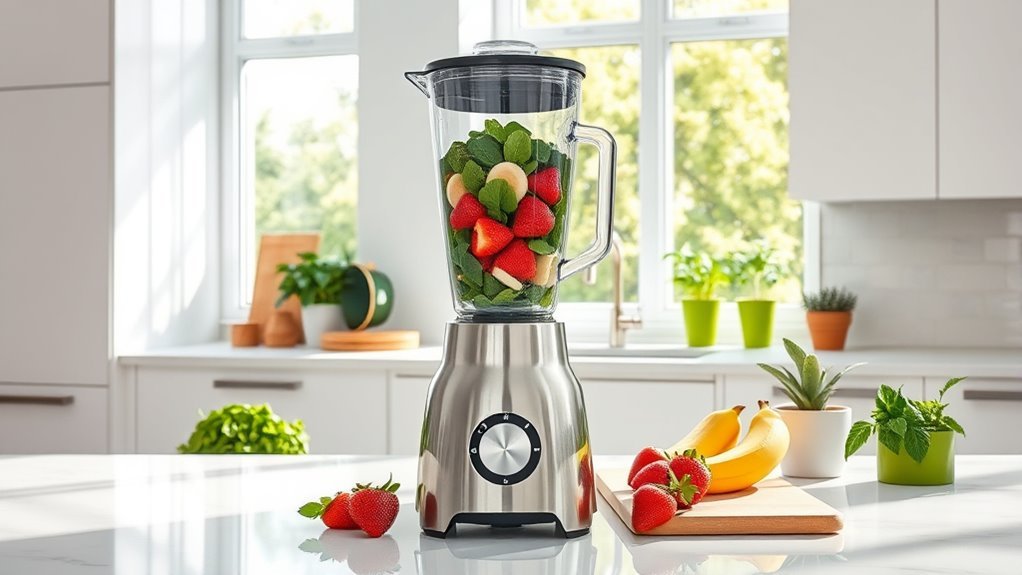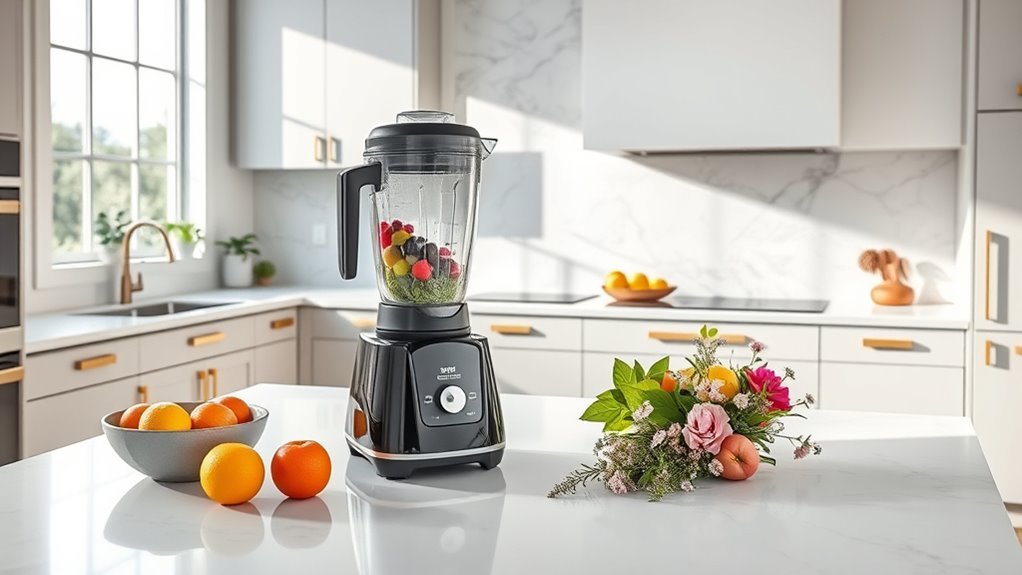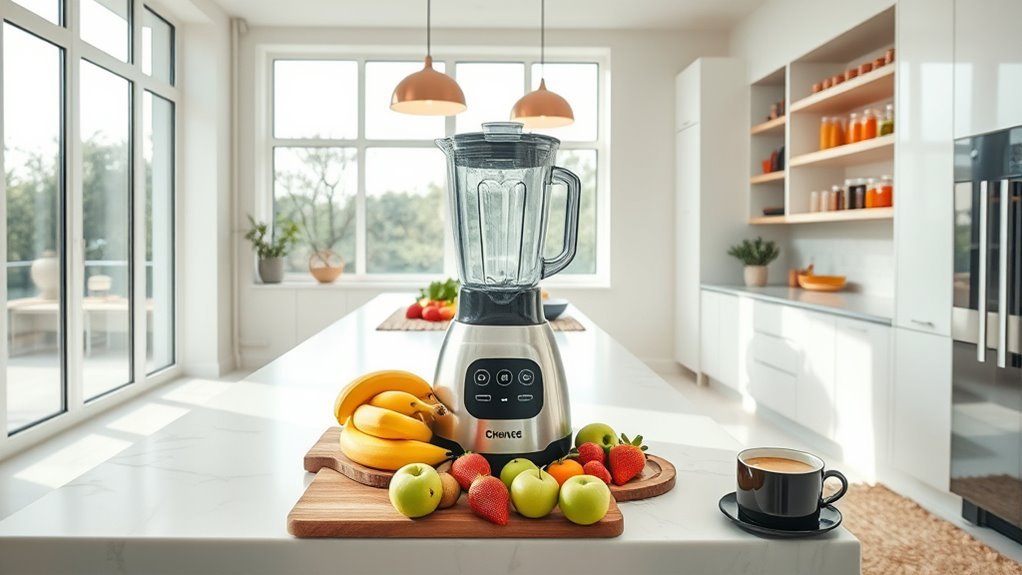For considerate blending in shared spaces, we recommend sticking to the sweet spot between 9 AM and 7 PM, with mid-afternoon being ideal. Weekend afternoons work best for batch processing. Early mornings (before 8 AM) and late nights (after 9 PM) are definite no-gos in apartments or shared housing. Quiet-technology blenders extend these windows, while commercial-grade ones demand stricter mid-day usage. But timing’s just the start of being a good blending neighbor.
Understanding Neighborhood Quiet Hours and Noise Ordinances

Before you rev up that blender, you’ll need to get familiar with your local quiet hours and noise regulations. We’re talking about those critical neighborhood quiet hours – typically 10 PM to 7 AM weekdays and 11 PM to 8 AM weekends – when your morning smoothie could land you in hot water.
Most cities enforce strict noise ordinances, and yes, loud appliances like blenders count. You’ll want to check your community guidelines, especially if you’re in an apartment complex where sound travels.
Don’t risk disturbing the peace and facing those hefty fines. Your neighbors have access to noise complaint hotlines, and they won’t hesitate to use them.
Smart move? Chat with your neighbors beforehand about your blending schedule. Trust us, it’s easier than dealing with angry neighbors or citations later.
Peak Activity Times for Blending in Shared Spaces
While everyone’s morning routine differs, there’s a clear pattern to when blending causes the most friction in shared spaces. Peak activity times hit hardest during breakfast hours, when we’re all rushing to whip up our morning smoothies. Let’s break down ideal blending windows to keep the peace.
| Time Period | Noise Tolerance | Best Practices |
|---|---|---|
| 7AM – 9AM | Low | Use quiet blender model |
| 12PM – 2PM | High | Ideal for prep work |
| 4PM – 8PM | Moderate | Quick blends only |
| After 8PM | Very Low | Avoid if possible |
Pro tip: Schedule your meal prep during non-peak hours. Late-night blending after 10 PM is asking for trouble – that’s when noise complaints spike. Weekend afternoons are your sweet spot for batch processing. Additionally, investing in a high-performance blender can significantly reduce blending noise and improve efficiency, making it easier to blend during off-peak hours without disturbing others.
Ideal Blending Hours for Different Living Situations

Since different living situations demand different blending strategies, we’ve got to tailor our timing to our specific home setup.
For those in shared living situations, ideal blending hours fall between 9 AM and 9 PM, when most people are awake and active.
Don’t blend late at night after 10 PM – your neighbors won’t appreciate the midnight smoothie session.
Early in the morning before 8 AM? That’s a hard no. Those peaceful morning hours are sacred in apartment buildings.
Instead, we recommend blending during mid-day when most people are at work or school. Additionally, investing in a high-performance blender can enhance your blending efficiency, allowing you to get the job done quicker and minimize noise during those ideal blending hours.
Better yet, prevent noise disturbances by communicating with neighbors about your typical blending schedule. A quick heads-up about when you’ll be using your blender can go a long way in maintaining peaceful coexistence.
Strategic Times for Batch Blending and Meal Prep
When it comes to batch blending and meal prep, timing isn’t just about convenience – it’s about strategy. We’ve found that mid-morning hours between 10 AM and 12 PM offer the perfect window for batch processing without disrupting others’ routines.
For maximum efficiency and minimal disturbance, we recommend strategic times like early afternoon (1-3 PM) when household activity dips. Late evening blending sessions around 8-9 PM work well too, as most people are winding down with personal activities.
Weekend batch prep during late morning is ideal – your housemates are typically awake and more tolerant of kitchen noise.
Here’s the golden rule: communicating with housemates about your blending schedule is non-negotiable. A quick heads-up about your meal prep plans keeps relationships smooth and complaints at bay.
Acceptable Time Windows for Different Blender Types

Because different blender types produce varying noise levels, you’ll need to match your blending schedule to your machine’s acoustics.
We’ve found that acceptable time windows vary considerably based on your blender type and apartment policies.
- Traditional high-speed blenders: Stick to 9 AM – 5 PM when neighbors are typically active and awake
- Quiet-technology blenders: Extend your blending hours from 8 AM to 8 PM without worry
- Variable-speed models: Use lower settings during early morning or evening hours
- Commercial-grade blenders: Restrict use to mid-day hours only, ideally 10 AM – 4 PM
Social Considerations When Using Blenders in Multi-Unit Housing
Living in multi-unit housing demands a strategic approach to blender usage that goes beyond mere timing.
We’ve got to contemplate our neighbors’ schedules and comfort levels when planning our smoothie-making adventures.
Let’s be smart about this. Schedule your blending during quieter hours when most residents are at work or school. Better yet, batch-blend your ingredients to reduce noise disturbances in shared living spaces.
Remember, a quick chat with neighbors about your blender usage can prevent potential conflicts.
Want to blend outside standard hours? Invest in soundproofing techniques. A dampening mat under your blender or a sound-reducing enclosure can work wonders.
These simple adjustments let you maintain your blending routine while keeping the peace in your community.
Frequently Asked Questions
Can I Use a Blender Late at Night?
We don’t recommend using a blender late at night. Instead, explore quieter blender types or add sound insulation for late night snacks. Consider preparing smoothie recipes earlier to maintain good kitchen etiquette and manage noise levels.
How to Blend Something Quietly?
Like wrapping a baby in a blanket, we’ll make our blender whisper-quiet by using a silicone mat underneath, positioning it away from walls, and covering it with a thick towel during operation.
How Do You Blend Things Quietly?
We can reduce blender noise by using soundproofing mats, covering with towels, positioning away from walls, and choosing quiet models designed with noise-reduction features. These accessories make smoothie prep more neighbor-friendly.
Will a Blender Wake Someone Up?
Like a motorcycle in your kitchen, our blender noise levels can definitely wake someone up. We’ll need considerate blending habits and noise-reducing techniques to avoid disturbing others during early morning smoothie prep.

